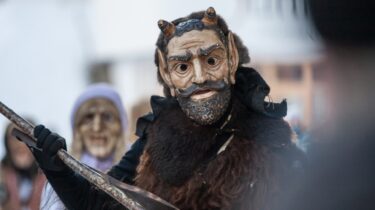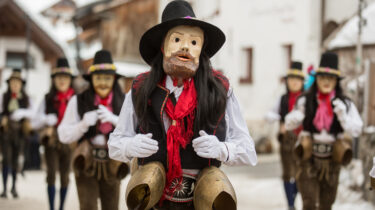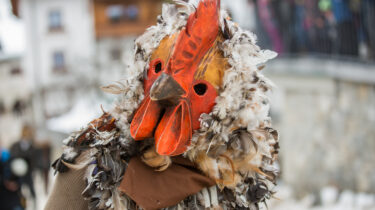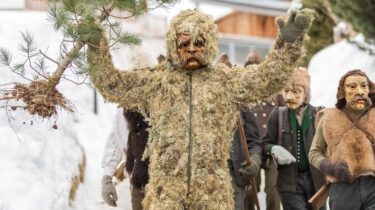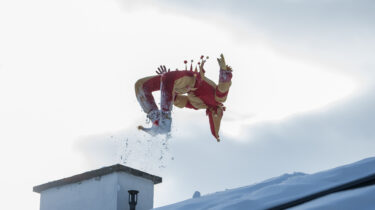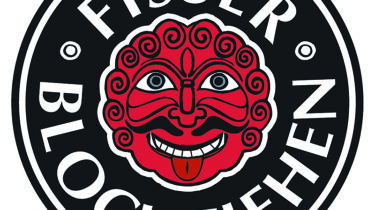Fisser Blochziehen!
Last updated on 06.12.2022
Pure Tradition at its Best in Serfaus-Fiss-Ladis.
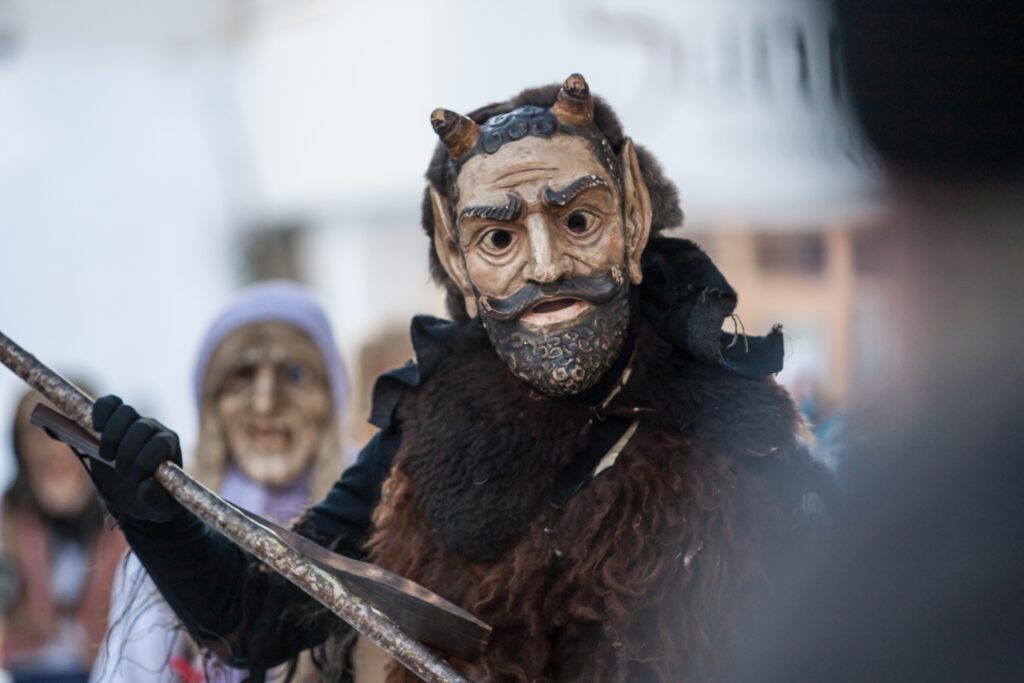
Every four years, the insidious Schwoaftuifl (tailed devil) makes his rounds at the Blochziehen in Fiss. But like a hundred years ago, he is not on the road alone, but together with witches, the Giggerler, Mohrelen and Schallner. A spectacle that depicts the struggle of good against evil – spring against winter. Perhaps the most original carnival custom in the Alpine region is firmly anchored in the genes of the village population and is a UNESCO intangible cultural heritage site.
The whole village has been waiting for this for a long time. When the church clock in Fiss strikes 12.30 pm on 29 January 2023, nothing will be the same in the village of 1,000 inhabitants for a few hours. The Blochziehen begins with the words “latz geats los!” (“off we go!”). With combined strength, in historical costumes and behind impressive wooden masks, the people in masks push a six-ton tree through the narrow streets of the mountain village of Fiss in the Upper Tyrolean Inntal valley. The Schallner and Mohrelen jump in front and announce the beginning of the procession. A short time later, the Paarlen, the Holzer and the Jäger follow. At the very back, the Schwoaftuifl, who was selected as the leading figure in 2023, tries to slow down the procession. With a large, forged fork, he dances around the Bloch (pinewood log) together with the fearsome witches and their flailing brooms. Meanwhile, the Bajatzl, who gambols around on the roofs and gets up to mischief, makes thousands of spectators laugh with his crazy ideas.
Legendary carnival tradition: a compulsory program for every Fisser
The Fisser Blochziehen is pure tradition and tells of the cohesion of the villagers. A matter of honour and firmly anchored in the genes of the inhabitants, because almost every Fisser’s household is connected in a certain way with the Blochziehen. Around 350 male villagers are directly involved in the old tradition. In short: the Blochziehen is both a duty and a freestyle event with a highly symbolic character for every Fisser. The Bloch, a pine tree about 30 meters long and weighing six tons, is felled by the men in late autumn. During the festive procession at the end of January, they then drag it through the village on wooden sleds. The Bloch itself represents a plough that breaks open the fields for sowing. The Mohrelen and Schallner with their friendly masks represent spring and drive away evil, demons and winter with their booming bells. In other words, the witches and the Schwoaftuifl. Today, the Blochziehen is one of the most famous traditions in the Alpine region and traditionally only takes place every four years.
The heroines behind the scenes
On the day of the Blochziehen, the mighty tree is pulled through the village by about 60 people wearing masks. By the way, only the men are allowed to slip into the costumes. But everyone in the village knows that even if they are more active behind the scenes, nothing would work without the women. They sew the costumes and put make up on the participants. Each family contributes to the success. For months, the inhabitants have been preparing for this important day and proudly display their elaborately carved wooden masks. With unbridled shouting and a lot of noise, they want to put an end to winter, drive away the evil and drag the Bloch to Fonnesplatz, where it is auctioned off to the highest bidder after the move by the mayor. The proceeds will be used for the Fisser Blochziehen itself, village community projects or social institutions.
Intangible UNESCO Cultural Heritage
The Blochziehen is a remnant of the spring and fertility rites of our pre-Christian ancestors and a thrilling spectacle whose open-air stage is the village centre of Fiss. In the past it was a custom of boys and single men, then married men also became involved. Today, a separate committee distributes the roles and manages the wooden masks and costumes. In 2011, UNESCO recognised the cultural-historical value of Fisser Blochziehen and included it in the National Register of Intangible Cultural Heritage in Austria. What many people don’t know: historically, the Blochziehen is connected with the marriage behaviour of the inhabitants of Fiss. It was only held when no one in the village had been married all year round.
By the way: what was originally only celebrated by adults every four years with great participation, has also been celebrated by the children and young people in Fiss for half a century. In a four-year rhythm – following the example of the greats. The next Kinderblochziehen will take place in January 2024.
More information about the Fisser Blochziehen can be found at www.blochziehen.at.
For further information about the holiday region Serfaus-Fiss-Ladis head to www.serfaus-fiss-ladis.at/en.
Further press information and free photographic material is available on our press portal under www.serfaus-fiss-ladis.at/en/Service/Press.
About Serfaus-Fiss-Ladis
True to the motto “The fantastic winter worlds of Serfaus-Fiss-Ladis”, the Tyrolean holiday region of represents variety and completely carefree winter holidays at the highest level. For singles as well as best friends, families or three-generation groups. Because the mountains there not only have plenty to offer the grown-ups, but also the little ones. The three mountain villages, each of which enjoy history in abundance, are situated on a sunny high plateau above the Upper Tyrolean Inntal valley, surrounded by the striking mountain peaks of the Samnaun mountain range and the Ötztal Alps. Between 1,200 and 2,828 meters above sea level, the holiday region offers all guests the best conditions for a multifaceted winter vacation: ativities for winter sports enthusiasts. Variety for the whole family. Adventures for thrill seekers. Breath-taking panoramas for those who like to take it slow. Extraordinary specialties for food lovers. And that is not only fabulous, but simply fantastic.

